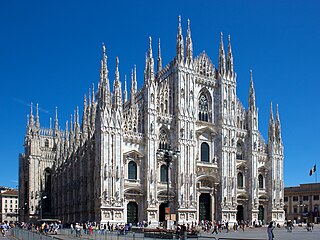
Milan Cathedral, or Metropolitan Cathedral-Basilica of the Nativity of Saint Mary, is the cathedral church of Milan, Lombardy, Italy. Dedicated to the Nativity of St. Mary, it is the seat of the Archbishop of Milan, currently Archbishop Mario Delpini.

Charles Borromeo was the Archbishop of Milan from 1564 to 1584 and a cardinal of the Catholic Church. He was a leading figure of the Counter-Reformation combat against the Protestant Reformation together with Ignatius of Loyola and Philip Neri. In that role he was responsible for significant reforms in the Catholic Church, including the founding of seminaries for the education of priests. He is honoured as a saint by the Catholic Church, with a feast day on 4 November.

Giovanni Ambrogio Figino was an Italian Renaissance painter from Milan.

Giovanni Battista Crespi, called Il Cerano, was an Italian painter, sculptor, and architect.

Federico Borromeo was an Italian cardinal and Archbishop of Milan, a prominent figure of Counter-Reformation in Italy. Federico was a hero of the plague of 1630, described in Alessandro Manzoni's historical novel, The Betrothed. He was a great patron of the arts and founded the Biblioteca Ambrosiana, one of the first free public libraries in Europe. In 1618 he added a picture gallery, donating his own considerable collection of paintings. His published works, mainly in Latin, number over 100. They show his interest in ecclesiastical archaeology, sacred painting, and collecting.

San Carlo ai Catinari, also called Santi Biagio e Carlo ai Catinari, is an early-Baroque style church in Rome, Italy. It is located on Piazza Benedetto Cairoli, 117 just off the corner of Via Arenula and Via dei Falegnami, a few blocks south of the church of Sant'Andrea della Valle.
Giovanni Balducci, called Il Cosci after his maternal uncle, was an Italian mannerist painter.

Giulio Cesare Procaccini (1574–1625) was an Italian painter and sculptor of the early Baroque era in Milan.

Pier Francesco Mazzucchelli was an Italian painter and draughtsman who was active in Milan. He is mainly known for his altarpieces, but his outstanding achievements are large decorative frescoes for the Sacro Monte di Varese and the Sacro Monte di Varallo.

Camillo Procaccini was an Italian painter. He has been posthumously referred to as the Vasari of Lombardy, for his prolific Mannerist fresco decoration.
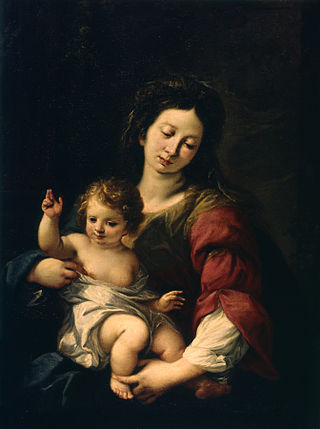
Carlo Francesco Nuvolone was an Italian painter of religious subjects and portraits who was active mainly in Lombardy. He became the leading painter in Lombardy in the mid-17th century, producing works on canvas as well as frescoes. Because his style was perceived as close to that of Guido Reni he was nicknamed il Guido della Lombardia.
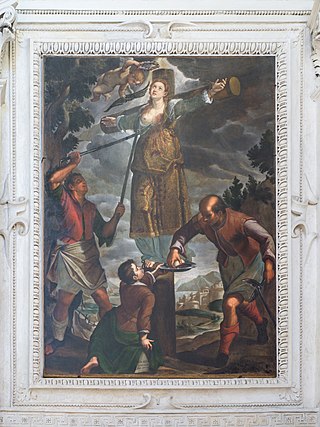
Grazio Cossali, sometimes called Orazio Cossali was an Italian painter who worked in Brescia, Cremona, and Venice, active during the Mannerist or early Baroque periods.

Luigi Pellegrini Scaramuccia (1616–1680) was an Italian painter and artist biographer of the Baroque period. He was a pupil, along with Giovanni Domenico Cerrini of the painter Guido Reni.

Filippo Abbiati (1640–1715) was an Italian painter of the early-Baroque period, active in Lombardy and Turin, together with Andrea Lanzani and Stefano Maria Legnani, he was a prominent mannerist painters from the School of Lombardy. Born in Milan, he was a pupil of the painter Antonio Busca. Alessandro Magnasco was one of his pupils along with Pietro Maggi and Giuseppe Rivola. Ticozzi claims he trained, along with Federigo Bianchi, with Carlo Francesco Nuvolone. Along with Bianchi, he painted the cupola of Sant'Alessandro Martire in Milan. Abbiati also painted a St. John preaching in the Wilderness for a church in Saronno.

Santa Maria dei Miracoli presso San Celso is a church and a sanctuary in Milan, Lombardy, northern Italy.
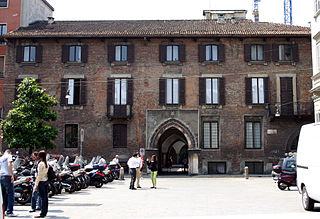
Palazzo Borromeo is a 14th-century building located at piazza Borromeo 12 in Milan, region of Lombardy, Italy. It was built as the home and business headquarters of the Borromeo family, merchant-bankers from Tuscany. Some of the building complex was badly damaged during World War II in Allied bombings of 1943 but was reconstructed and restored to its 15th-century appearance. It contains an important fresco cycle from the 1440s and is one of the finest examples of a Milanese patrician palace from the early Renaissance.

The San Carlone or Sancarlone or the Colossus of San Carlo Borromeo is a massive copper statue by Giovanni Battista Crespi, erected between 1614 and 1698, near Arona, Italy. It represents Charles Borromeo, a Catholic saint and former archbishop of Milan. According to sculptor Frédéric Auguste Bartholdi "The statue of St. Charles Borromeo is the first known example of a statue of repousse copper, worked with the hammer inside and outside, and freely supported on iron beams". Today, the complex is maintained by Milan's Biblioteca Ambrosiana.

The Sacro Monte di Arona, devoted to Charles Borromeo, is part of the Sacri Monti built in the 16th and 17th centuries. It is located in the territory of the town of Arona, province of Novara, region of Piedmont, Italy.
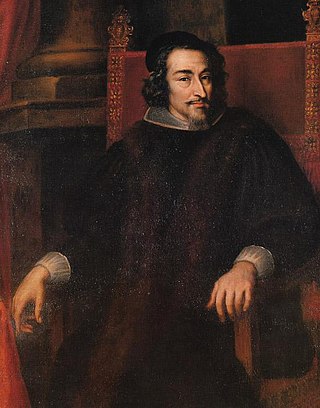
Bartolomeo III Arese count of Castel Lambro born in Milan on 23 October 1590 and died in the same city on 23 September 1674 was an Italian nobleman, politician, and prominent member of the House of Arese.

The Sanctuary of Madonna of Miracles is a Roman Catholic Marian sanctuary located in Corbetta, province of Milan, Lombardy, Italy. The sanctuary is dedicated to the Madonna of the Miracles, whose miraculous frescoed image, known as Madonna di Corbetta, was declared in 1955 to be the patron of the Magentino area in 1955 by the then archbishop of Milan and future pope Paul VI.




























